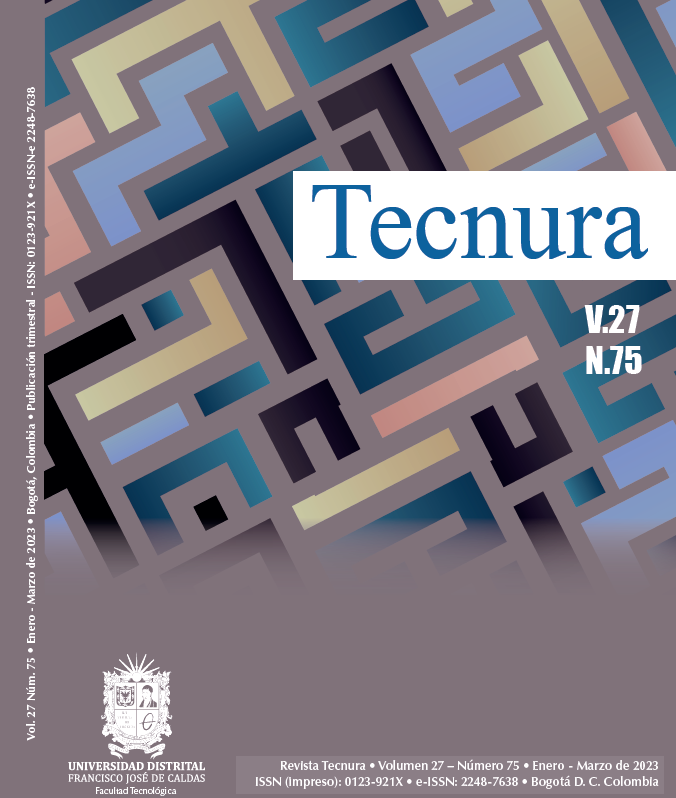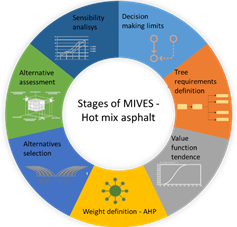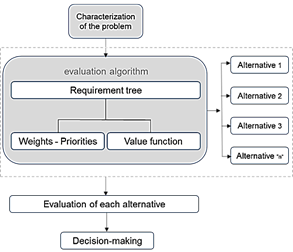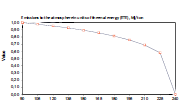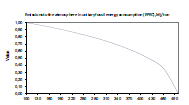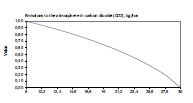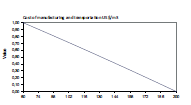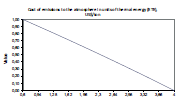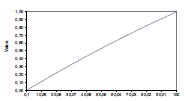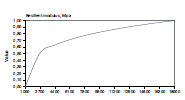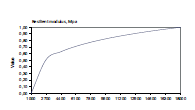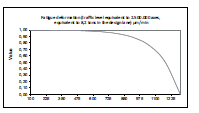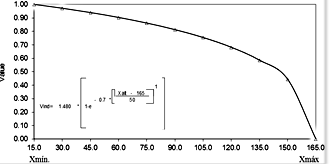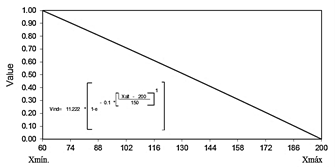DOI:
https://doi.org/10.14483/22487638.18929Publicado:
01-01-2023Número:
Vol. 27 Núm. 75 (2023): Enero - MarzoSección:
Estudio de casoUn análisis multicriterio para la toma de decisiones en la selección de una mezcla asfáltica en pavimentos
A Multi-Criteria Analysis for decision-making in the selection of an asphalt mixture on pavements
Palabras clave:
multi-criteria methodology, AHP, MIVES, flexible pavements (en).Palabras clave:
metodología multicriterio, AHP, MIVES, pavimentos flexibles (es).Descargas
Referencias
Aguado, A., del Caño, A., de la Cruz, M. del P., Gómez, D., & Josa, A. (2012). Sustainability assessment of concrete structures within the Spanish structural concrete code. Journal of Construction Engineering and Management, 138(2), 268-276. https://doi.org/10.1061/(ASCE)CO.1943-7862.0000419 DOI: https://doi.org/10.1061/(ASCE)CO.1943-7862.0000419
Aguado, A., Manga, R., Ormazábal, G. (2006). La medida de la sostenibilidad en edificación industrial. Los Autores. https://futur.upc.edu/692739
Al-Busaltan, S., Al-Nageim, H., Atherton, W., & Sharples, G. (2012). Mechanical properties of an upgrading cold-mix asphalt using waste materials. Journal of Materials in Civil Engineering, 24(12), 1484-1491. https://doi.org/10.1061/(ASCE)MT.1943-5533.0000540 DOI: https://doi.org/10.1061/(ASCE)MT.1943-5533.0000540
Arroyo, P., Herrera, R., Salazar, L., Giménez, Z., Martínez, J., & Calahorra, M. (2018). A new approach for integrating environmental, social, and economic factors to evaluate asphalt mixtures with and without waste tires. Revista Ingeniería de Construcción, 33(3), 301-314. https://doi.org/10.4067/S0718-50732018000300301 DOI: https://doi.org/10.4067/S0718-50732018000300301
Bueche, N., & Dumont, A.-G., (2016) Decision aid model for asphalt mixture choice. In J.-M. Torrenti, F. La Torre (Eds.), Materials and Infrastructures 1 (vol. 5A, pp. 75-86). John Wiley & Sons. https://doi.org/10.1002/9781119318583.ch6 DOI: https://doi.org/10.1002/9781119318583.ch6
Bulla-García, Y. A., Rodríguez-Álvarez, A. T., & Higuera-Sandoval, C. H. (2017). Análisis comparativo de una mezcla densa en caliente MDC-19 y una mezcla densa en frío MDF-19. Ingenio Magno, 8(1), 20-42. Chelelgo, K., Abiero Gariy, Z. C., & Shitote, S. M. (2018). Laboratory Mix Design of Cold Bitumen Emulsion Mixtures Incorporating Reclaimed Asphalt and Virgin Aggregates. Buildings, 8(12), 177. https://doi.org/10.3390/buildings8120177 DOI: https://doi.org/10.3390/buildings8120177
Casanovas, M. del M. (2014). Metodología para la evaluación y seguimiento de procedimientos constructivos de forma sostenible e integrada [Doctoral dissertation, Universitat Politècnica de Catalunya]. https://upcommons.upc.edu/handle/2117/95596
Castillo, E., Acevedo, L. & Orduz, J. (2000). Perfil tecnológico ambiental de la industria de mezclas asfálticas en Colombia. Revista ION, 16(1), 1318. https://revistas.uis.edu.co/index.php/revistaion/article/view/1318
D’Aula, E. (2012). Base para un índice de calidad acústica global de la arquitectura interior: aplicación a los espacios comerciales urbanos [Doctoral dissertation, Universitat Politècnica de Catalunya]. http://www.tdx.cat/handle/10803/81117
De la Fuente, A., Pons, O., Josa, A., & Aguado, A. (2016a). Multi-criteria decision making in the sustainability assessment of sewerage pipe systems. Journal of Cleaner Production, 112(5), 4762-4770. https://doi.org/10.1016/j.jclepro.2015.07.002 DOI: https://doi.org/10.1016/j.jclepro.2015.07.002
De la Fuente, A., Armengou, J., Pons, O., & Aguado, A. (2016b). Multi-criteria decision-making model for assessing the sustainability index of wind-turbine support systems: Application to a new precast concrete alternative. Journal of Civil Engineering and Management, 23(2), 194-203. https://doi.org/10.3846/13923730.2015.1023347 DOI: https://doi.org/10.3846/13923730.2015.1023347
De la Rosa, R. H., Alonso-Aenlle A., & Villegas-Muñoz, N. (2018). Evaluation of natural additives for warm asphalt mix. Revista de la Construccion, 17(2), 330-336. https://doi.org/10.7764/RDLC.17.2.330 DOI: https://doi.org/10.7764/RDLC.17.2.330
Del Caño, A., Gómez, D., & de la Cruz, M. del P. (2012). Uncertainty analysis in the sustainable design of concrete structures: A probabilistic method. Construction and Building Materials, 37, 865-873. https://doi.org/10.1016/j.conbuildmat.2012.04.020 DOI: https://doi.org/10.1016/j.conbuildmat.2012.04.020
Gilani-Blanco, A., & Fuente, A. (2017). A new sustainability assessment approach based on stakeholder’s satisfaction for building façades. Energy Procedia, 115, 50-58. https://doi.org/10.1016/j.egypro.2017.05.006 DOI: https://doi.org/10.1016/j.egypro.2017.05.006
Hernández-Santibáñez, M. I., Giraldo-Correa, L. F., Gaviria-Ramírez, L. A., Wilches-David, Á. M., Osorio-Gómez, J. C. (2017). Priorización de despachos con AHP difuso y Topsis. Revista Tecnura, 21(52), 102-110. https://doi.org/10.14483/udistrital.jour.tecnura.2017.2.a08 DOI: https://doi.org/10.14483/udistrital.jour.tecnura.2017.2.a08
Hernández-Suárez, C., Páez, I., Giral-Ramírez, D. A. (2015). Modelo AHP-VIKOR para handoff espectral en redes de radio cognitiva. Revista Tecnura, 19(45), 29-39. https://doi.org/10.14483/udistrital.jour.tecnura.2015.3.a02 DOI: https://doi.org/10.14483/udistrital.jour.tecnura.2015.3.a02
Hosseini Amin, S. M., de la Fuente, A., & Pons, O. (2016). Multicriteria decision-making method for sustainable site location of post-disaster temporary housing in urban areas. Journal of Construction Engineering and Management, 142(9), 3. https://doi.org/10.1061/(ASCE)CO.1943-7862.0001137 DOI: https://doi.org/10.1061/(ASCE)CO.1943-7862.0001137
Ledesma, F. R. (2015). Análisis de costos para la toma decisiones en la industria petrolera [Undergraduate thesis, Universidad Nacional de Cuyo]. https://bdigital.uncu.edu.ar/objetos_digitales/7546/ledesma-facundo.pdf
Mel, J., Gómez, D., de la Cruz, P., & del Caño, A. (2015). Análisis de sensibilidad y estudio crítico del modelo de evaluación de la sostenibilidad de la Instrucción Española de Hormigón Estructural. Informes de La Construcción, 67(539), e106. https://doi.org/10.3989/ic.14.126 DOI: https://doi.org/10.3989/ic.14.126
Miller, G. (1956). The magical number seven, plus or minus two: Some limits on our capacity for processing information. Psychological Review, 63(2), 81-97. https://doi.org/10.1037/h0043158 DOI: https://doi.org/10.1037/h0043158
Ormazabal, G., Viñolas, B., & Aguado, A. (2008). Enhancing value in crucial decisions: Line 9 of the Barcelona subway. Journal of Management in Engineering, 24(4), 265-272. https://doi.org/10.1061/(ASCE)0742-597X(2008)24:4(265) DOI: https://doi.org/10.1061/(ASCE)0742-597X(2008)24:4(265)
Pardo-Bosch, F., & Aguado, A. (2014). Investment priorities for the management of hydraulic structures. Structure and Infrastructure Engineering, 11(10), 1338-1351. https://doi.org/10.1080/15732479.2014.964267 DOI: https://doi.org/10.1080/15732479.2014.964267
Pardo-Bosch, F., & Aguado, A. (2016). Sustainability as the key to prioritize investments in public infrastructures. Environmental Impact Assessment Review, 60, 40-51. https://doi.org/10.1016/j.eiar.2016.03.007 DOI: https://doi.org/10.1016/j.eiar.2016.03.007
Pasha, A. Mansourian, A., & Ravanshadnia, M. (2020). A hybrid fuzzy multi-attribute decision making model to select road pavement type. Soft Computing, 24, 16635-16148. https://doi.org/10.1007/s00500-020-04928-2 DOI: https://doi.org/10.1007/s00500-020-04928-2
Pérez-Acosta, S., & Lemus-Franco, W. Y. (2018). Comportamiento de una mezcla asfáltica densa en frío adicionada con partículas de policloruro de vinilo (PVC) [Specialization thesis, Universidad Católica de Colombia]. https://repository.ucatolica.edu.co/handle/10983/16072
Pons, O. & Aguado, A. (2012). Integrated value model for sustainable assessment applied to technologies used to build schools in Catalonia, Spain. Building and Environment, 53, 49-58. https://doi.org/10.1016/j.buildenv.2012.01.007 DOI: https://doi.org/10.1016/j.buildenv.2012.01.007
Pons, O. & de la Fuente, A. (2013). Integrated sustainability assessment method applied to structural concrete columns. Construction and Building Materials, 49, 882-893. https://doi.org/10.1016/j.conbuildmat.2013.09.009 DOI: https://doi.org/10.1016/j.conbuildmat.2013.09.009
Pons, O., de la Fuente, A., & Aguado, A. (2016). The use of MIVES as a sustainability assessment MCDM method for architecture and civil engineering applications. Sustainability, 8(5), 460. https://doi.org/10.3390/su8050460 DOI: https://doi.org/10.3390/su8050460
Pujadas, P., Pardo-Bosch, F., Aguado-Renter, A., & Aguado, A. (2017). MIVES multi-criteria approach for the evaluation, prioritization, and selection of public investment projects. A case study in the city of Barcelona. Land Use Policy, 64, 29-37. https://doi.org/10.1016/j.landusepol.2017.02.014 DOI: https://doi.org/10.1016/j.landusepol.2017.02.014
Pujadas, P., Cavalaro, S. H. P., & Aguado, A. (2018). Mives multicriteria assessment of urban-pavement conditions: application to a case study in Barcelona. Road Materials and Pavement Design, 20(8), 1827-1843. https://doi.org/10.1080/14680629.2018.1474788 DOI: https://doi.org/10.1080/14680629.2018.1474788
Reyes, J. P., San-José, J. T., Cuadrado, J., & Sancibrian, R. (2014). Health & Safety criteria for determining the sustainable value of construction projects. Safety Science, 62, 221-232. https://doi.org/10.1016/j.ssci.2013.08.023 DOI: https://doi.org/10.1016/j.ssci.2013.08.023
Reyes-Ortiz, Ó. J., Álvarez, A., & Valdés-Vidal, G. (2018). Evaluación mecánica de mezclas asfálticas frías fabricadas con reemplazo de llenante mineral. Informacion Tecnologica, 25(2), 93-102. https://doi.org/10.4067/S0718-07642014000200011 DOI: https://doi.org/10.4067/S0718-07642014000200011
Rondón-Quintana, H., Fernández-Gómez, W., & Castro-López, W. (2010). Evaluación de las propiedades mecánicas de una mezcla densa en caliente modificada con un desecho de polietileno de baja densidad (PEBD). Revista Ingeniería de Construcción, 25(1), 83-94. https://doi.org/10.4067/s0718-50732010000100004 DOI: https://doi.org/10.4067/S0718-50732010000100004
Ruiz, M. P., Acevedo, P., & Puello-Méndez, J. (2014). Evaluation of the environmental impact of a dense graded hot mix asphalt (HMA). Chemical Engineering Transactions, 36, 229-234. https://doi.org/10.3303/CET1436039
Santos, J., Flintsch, G., & Ferreira, A. (2017). Environmental and economic assessment of pavement construction and management practices for enhancing pavement sustainability. Resources, Conservation and Recycling, 116, 15-31. https://doi.org/10.1016/j.resconrec.2016.08.025 DOI: https://doi.org/10.1016/j.resconrec.2016.08.025
Saaty, T. L. (2004). Decision making – The Analytic Hierarchy and Network Processes (AHP/ANP). Journal of Systems Science and Systems Engineering, 13(1), 1-35. https://doi.org/10.1007/s11518-006-0151-5 DOI: https://doi.org/10.1007/s11518-006-0151-5
Saaty, R. W. (2017). A personal view of the development of the AHP. International, Journal of the Analytic Hierarchy Process, 9(3), 556. https://doi.org/10.13033/ijahp.v9i3.556 DOI: https://doi.org/10.13033/ijahp.v9i3.556
San-José, J. T., Losada, R., Cuadrado, J., & Garrucho, I. (2007). Approach to the quantification of the sustainable value in industrial buildings. Building and Environment, 42(11), 3916-3923. https://doi.org/10.1016/j.buildenv.2006.11.013 DOI: https://doi.org/10.1016/j.buildenv.2006.11.013
San-José, J. T, & Cuadrado-Rojo, J. (2010). Industrial building design stage based on a system approach to their environmental sustainability. Construction and Building Materials, 24(4), 438-447. https://doi.org/10.1016/j.conbuildmat.2009.10.019 DOI: https://doi.org/10.1016/j.conbuildmat.2009.10.019
Slebi-Acevedo, C., Pascual-Muñoz, P., Lastra-González, P., & Castro-Fresno, D., (2019). A multi-criteria decision-making analysis for the selection of fibers aimed at reinforcing asphalt concrete mixtures. International Journal of Pavement Engineering, 22(6), 763-779. https://doi.org/10.1080/10298436.2019.1645848 DOI: https://doi.org/10.1080/10298436.2019.1645848
Viñolas, B., Cortés, F., Marques, A., Josa, A., & Aguado, A. (2009, November 5-6). MIVES: modelo integrado de valor para evaluaciones de sostenibilidad [Conference presentation]. ICSMM II Congrés Internacional de Mesura i Modelització de La Sostenibilitat, Barcelona, Spain. https://core.ac.uk/download/pdf/41762288.pdf
UN-CEPAL (2018a). Plan de acción regional para la implementación de la nueva agenda urbana. https://repositorio.cepal.org//handle/11362/42144
UN-CEPAL (2018b). Segundo informe anual sobre el progreso y los desafíos regionales de la Agenda 2030 para el Desarrollo Sostenible en América Latina y el Caribe Comisión Económica para América Latina y el Caribe. https://www.cepal.org/fr/node/45972
Villegas-Flores, N. (2009). Análisis de valor en la toma de decisiones aplicado a carreteras [Doctoral dissertation, Universitat Politècnica de Catalunya]. https://upcommons.upc.edu/handle/2117/93138/discover
Villegas, N., & Parapinski dos Santos, A. C. (2013). Análisis de indicadores para determinar el grado de sostenibilidad en concretos especiales. Revista Tecnura, 17(38), 12-25. https://doi.org/10.14483/udistrital.jour.tecnura.2013.4.a01 DOI: https://doi.org/10.14483/udistrital.jour.tecnura.2013.4.a01
Zavadskas, E. K., Turskis, Z. & Kildiene, S. (2014). State of art surveys of overviews on MCDM/MADM methods. Technological and Economic Development of Economy, 20(1), 165-179. https://doi.org/10.3846/20294913.2014.892037 DOI: https://doi.org/10.3846/20294913.2014.892037
Cómo citar
APA
ACM
ACS
ABNT
Chicago
Harvard
IEEE
MLA
Turabian
Vancouver
Descargar cita
Recibido: 20 de febrero de 2022; Aceptado: 26 de septiembre de 2022
ABSTRACT
Objective:
This research presents a novel multi-criteria methodology that allows evaluating two asphalt materials used in the paving sector, aiming to provide guidelines for selecting a material under a sustainable profile. This methodological tool allows evaluating characteristics and indicators associated with the behavior of an asphalt mixture in an integrated and consistent way as well as with environmental impact.
Methodology:
A sustainability parameter associated with the study of two materials from the paving sector was obtained. The main characteristics of a hot asphalt mixture and a cold mixture under the same contour conditions were evaluated. Regarding the multi-criteria model, the concept of decision theory was taken, supported by the MIVES methodology and the utility function, thus allowing to evaluate and compare the indicators proposed for this analysis case.
Results:
The sustainability index was obtained for the two materials studied. The cold asphalt mixture obtained a value of 0,76, representing an overall better performance in the three axes analyzed (environmental, economic, and operation). On the other hand, the hot mixture obtained an index of 0,57, a value inherent to a less positive response than the cold mixture.
Conclusions:
The developed methodology allowed for the incorporation of variables and indicators of different units of measurement and diverse nature. Obtaining a sustainability index in asphalt materials represents a significant advance in the application of multi-criteria methodologies.
Keywords:
multi-criteria methodology, AHP, MIVES, flexible pavements.RESUMEN
Objetivo:
Esta investigación presenta una novedosa metodología multicriterio que permite evaluar dos materiales asfálticos utilizados en el sector de la pavimentación, en aras de aportar directrices al momento de seleccionar un material bajo un perfil sostenible. Esta herramienta metodológica permite evaluar características e indicadores asociados al comportamiento de una mezcla asfáltica de forma integrada, consistente y con impacto medioambiental.
Metodología:
Se obtuvo un parámetro de sostenibilidad asociado al estudio de dos materiales del sector de la pavimentación. Se evaluaron las principales características de una mezcla asfáltica en caliente y una mezcla fría bajo las mismas condiciones de contorno. Con respecto al modelo multicriterio, se tomó el concepto de teoría de la decisión, con apoyo de la metodología MIVES y la función de utilidad, permitiendo evaluar y comparar los indicadores propuestos para este caso de análisis.
Resultados:
Se obtuvo el índice de sostenibilidad para los dos materiales estudiados. La mezcla asfáltica fría obtuvo un valor de 0,76, representando de forma global un mejor desempeño en los tres ejes analizados (medioambiental, económico y de operación). Por otro lado, la mezcla en caliente obtuvo un índice de 0,57, valor inherente a una respuesta menos positiva que la mezcla fría.
Conclusiones:
La metodología desarrollada permitió incorporar variables e indicadores con unidades de medición distintas y de naturaleza diversa. La obtención de un índice de sostenibilidad en materiales asfálticos supone un avance significativo en la aplicación de metodologías multicriterio.
Palabras clave:
metodología multicriterio, AHP, MIVES, pavimentos flexibles.1. INTRODUCTION
In recent decades, in the asphalt technology sector, the development of hot asphalt mixtures for the construction of treads in pavement structures has prevailed (Pérez-Acosta & Lemus-Franco, 2018). It is known that the production of asphalt mixtures is associated with environmental pollution problems, which generates significant economic impacts. In addition to this, high oil production costs imply inconsistent markets in prices per barrel (Ledesma, 2015), indicating the need to seek new technological proposals in the paving sector.
The need to review the impacts of hot asphalt mixtures has been a categorical trend in recent years (Al-Busaltan et al., 2012; de la Rosa et al., 2018; Rondón-Quintana et al., 2010; Ruiz et al., 2014). In that sense, space has been gained in the implementation of cold asphalt mixtures, under the premise of reducing energy consumption and alleviating the environmental impact generated by greenhouse gases emitted by hot asphalt production plants (Chelego et al., 2018).
On the other hand, cold asphalt mixtures are produced from fine and coarse aggregates by adding an asphalt emulsion, without the need to heat the components, as is the case of hot asphalt mixtures (Bulla-García et al., 2017). In this regard, several peculiarities have been analyzed and studied in recent years, given benefits such as the easy extension and compaction of the material, improved adhesion between particles, and mixture stability (Reyes et al., 2018).
The prevailing need to create and design new models that meet the demands of sustainability in the asphalt mix technology sector has led to reductions in design quality standards and manufacturing temperatures (and compaction), as well as to substantial improvements in workers’ health, among others.
Table 1 shows several international experiences addressing the use of multi-criteria models when evaluating asphalt mixtures. It is necessary for each of these studies to be analyzed with the particularities and specific parameters of each case.
Source: Authors
Table: 1 Multi-criteria models in the flexible pavement technology sector
Author
Multi-criteria models used
Purpose of the study
Bueche & Dumont (2016)
EPFL‐LAVOC Model
To assess warm mix asphalt (WMA) and hot mix asphalt (HMA)
Santos et al. (2017)
Life cycle cost/Life cycle assessment
To measure the efficiency of environmental and economic aspects
"Choosing by Advantages" (CBA tool)
Arroyo et al. (2018)
Multi-criteria decision-making method
To use the End Life of Tires (ELT) in asphalt mixtures in developing countries
Slebi-Acevedo et al. (2019)
The Weighted Aggregate Sum Product Assessment (WASPAS) methodology
To select fibers for bituminous mixtures
Technique for Order of Preference by Similarity to Ideal Solution (TOPSIS)
Fuzzy Analytic Hierarchy Process (FAHP)
Pasha et al. (2020)
Fuzzy Analytic Network Process (FANP)
To select the ideal pavement alternative (ranking)
Although there are numerous applications and multicriteria models with certain objectives, there is a significant lack of models that allow characterizing and evaluating constructive solutions in an integrated way. In other words, the model proposed in this study provides a new perspective of evaluation and comparison between two materials that can be homologated in terms of their economic, operational, and environmental aspects.
2. SYSTEM LIMITS
For the development of this study, two constructive pavement solutions were used. On the one hand, an alternative based on a binder mixture and hot aggregate (DHD, dense hot mix- manufactured and compacted) and a cold dense mixture (DC, dense-cold) was selected. It is important to mention that the experimental characterization of each of the selected alternatives has been developed by Bulla-García et al. (2017) and has served as a basis for comparing the responses with the proposed multi-criteria model.
The study conducted by Bulla-García et al. (2017) sought to analyze different technical, economic, and environmental aspects. The analysis presented in this study considers the use of the ‘modified Marshall’ methodologies for the DHD and the ‘Marshall Illinois’ ones for the DC. Asphalt mixtures have been characterized with AC 60-70 and CRL-1 emulsions for DHD and DC, respectively, using the same aggregate for both solutions.
The adoption of the variables treated in the study by Bulla-García et al. (2017) allowed calibrating the decision-making methodology proposed in this work. The transition from an experimental phase to the methodological phase is a complement between different areas of analysis and evaluation, i.e., a starting point in juxtaposition and comparison when evaluating flexible pavement components.
It is important to highlight that only those two types of asphalt mixes have been defined in this study. However, the method can be applied to various types of comparable materials. The parameters and indicators used in this study were defined by the characteristics of the materials themselves. Thus, the parameters should be adjusted when evaluating other constructive solutions with regard to their technological responses.
3. MIVES MULTI-CRITERIA ANALYSIS FOR THE CASE OF THE ASPHALT SUSTAINABILITY INDEX
Multi-criteria decision-making (MCDM) occurs when the decision-maker must select between a group of alternatives or solutions, considering the diversity of criteria and assessments (Zavadskas et al., 2014). The MIVES method is a multi-criteria analysis methodology that assesses alternatives with the clear objective of solving a specific problem.
This methodology was designed based on the utility theory, obtaining a ‘value index’ (of each alternative), a product of the weighted total of the assessments of the criteria and the indicators considered (Aguado et al., 2006). It is important to highlight that the MIVES methodology allows configuring and characterizing all the preferences of the decision-maker in a phase prior to the creation of possible alternatives.
This implies that the decision-maker defines the aspects to be assessed from the start and their form of evaluation. The advantage of this approach means that decision-making is not affected by the responses of the alternatives, thus reducing the possibility of any type of subjectivity.
Figure 1 depicts the seven stages of the MIVES multi-criteria methodology. In the case of the first stage, called "Delimitation of the decision" the system limits and boundary conditions are defined. Decision-making is organized, observing the agents that intervene before the problem can be solved.
Figure 1: Characterization of the stages of MIVES
On the other hand, the limits of the system condition the decision-making process in three main axes: requirements, components (to be analyzed), and life cycle (of the problem). In these stages, the circumstances surrounding the decision-making process are observed (i.e., temporal, geographical and environmental factors, as well as workers’ health, among others) (Aguado et al., 2006).
In light of the above, Table 2 reflects the different applications of the MIVES model in the construction sector. It shows the methodological advances, application areas, and main attributes represented in each case.
Source: Authors
Table 2: MIVES applications in the construction sector
Methodology
Application attributes
Application area/Methodological advances
Aguado et al. (2012)
Procedures to assess sustainability in structural concrete structures Spanish Code
Structural concrete legislation/Annex 14 structural concrete
del Caño et al. (2012)
Concrete works during all life cycle
Structures of concrete/Life cycle
Technology in educational structures
D’Aula (2012)
Acoustic Quality: Index of Architecture
Architecture/Evaluation models in the field of acoustics.
Pons and de la Fuente (2016)
Reinforced concrete elements, mechanical conditions, geometry and their processes
Structures/Functional - structure.
Reyes et al. (2014)
Construction projects integrating health and safety issues
Occupational Health & Safety/Social impact
de la Fuente et al. (2016)
Sewer pipes
Sewer systems/Sanitation and new materials
Hosseini et al. (2016)
Provisional housing, reduce environmental and economic impacts
Civil Construction/Social welfare
de la Fuente et al. (2016b)
Wind turbines
Renewable energy
Advantages and limitations for sustainable measures
Gilani and Fuente (2016)
Facades in housing
Civil Construction/Architecture criteria
Pujadas et al. (2018)
Urban pavements capacity and damage
Public politics
Villegas and Parapinski dos Santos (2013)
Analysis of new materials under the sustainable context
Civil construction
The requirements tree is elaborated with the clear objective of ordering and grouping the variables selected in the first phase. The third stage defines the value functions for the entire system. The objective of the value functions is to integrate and transfer variables with different units of measurement (for example, US $, emissions, tons, %, etc.). In the allocation of weights (fourth stage), the degree of importance between the different variables conceived in the first phase is assigned and determined. That is, each variable or attribute has a relative importance with respect to the need for decision-making. For this, the priority assignment tool defined by Saaty (2004) has been used, which deals with the comparison of variables by means of a square matrix and degrees of consistency.
After defining the structure of the problem and the established weights, the alternatives that support the decision are specified. It is important to highlight that there is no limitation to evaluate alternatives if they are comparable and homologous between them.
The evaluation of alternatives (sixth phase) is conducted via the mathematical instrument provided by the MIVES methodology, which will be detailed in subsequent sections. Finally, a sensitivity analysis is staged to observe the incidence of each of the variables analyzed with respect to the measuring instrument and the responses of each selected alternative.
Figure 2 shows the diagram and methodological organization of the MIVES methodology. It is important to highlight that the alternatives are outside the creation and structure of the decision-making process, reducing the possibility of subjective approaches and biases during the evaluation process. MIVES represents a significant advance in the evaluation of variables with different units of measurement, following an approach that observes the life cycle of each decision.
Figure 2: General algorithm of the MIVES multi-criteria model
The MIVES method has been conceived and used (initially) to evaluate construction projects on a sustainable basis. Such initiatives are aimed at measuring alternatives ranging from the analysis and evaluation of investments in the public construction sector (Pujadas et al., 2017) to environmental valuations associated with the sector that allow measuring the responses of indicators throughout the entire cycle of the project (Viñolas et al., 2009).
There are different applications that have been used to measure the responses of the indicators in the industrial sector (Pons et al., 2016; San-José et al., 2007; San-José & Cuadrado-Rojo, 2010) by means of MIVES. This methodology has been used to analyze the networks of infrastructure works such as tunnels (Ormazabal et al., 2008), to compare structural hydraulic networks (Pardo-Bosch & Aguado, 2014, 2016), and in civil construction projects (Pons & Aguado, 2012; Casanovas, 2014), allowing to compare alternatives with sustainable rigor.
It is important to note that the structural concrete code has been evaluated through this multi-criteria methodology, with satisfactory results (CPH, Spanish Structural Concrete Standard, 2008) (Mel et al., 2015). Finally, for the specific case of works on land roads (paving), Pujadas et al. (2017) and Aguado et al. (2012) integrate concepts of quality in paving, evaluating it with the MIVES multi-criteria methodology.
Other sectors have also been studied through the MIVES model. De la Fuente et al. (2016b) establish the necessary indicators aiding in the selection of wind turbines. The authors compare solutions to claims in urban areas. Villegas-Flores (2009) contextualizes the comparison of indicators that measure the performance of university departments, obtaining criteria for the distribution of financial resources based on teacher productivity.
The diversity and application of studies carried out under this multi-criteria model has gained strength in the last decade. Figure 3 depicts the tree of requirements defined for this specific case study. The structure of the tree has been arranged in three axes or requirements: environmental, economic, and operational. The decision-making process has been conceived in such a way that all criteria and indicators are measurable with some ease and scientific rigor.
Environmental requirements have been limited to the context of environmental pollution, namely regarding the reduction of performance temperatures, harmful emissions, and raw materials consumption. As for performance temperatures, two types of temperatures have been considered: those involved in the manufacturing of the asphalt mixture and those involved in compaction. These indicators have been selected by assuming that there is a need to reduce environmental impacts, given the high temperatures taking place in both processes.
In this case, particular care has been taken to address the various concepts of emission reduction expressed at the 21st Conference of the parties to the United Nations Framework Convention on climate change, held in Paris in December 2015. This accord will be adopted from 2021, aiming to keep the global temperature rise below 2°, thus promoting climate resilience and low-carbon development (UN-CEPAL, 2018a).
This study contemplates the reduction and consumption of thermal energy and carbon dioxide emissions (which are contemplated in the emission criteria) that favor meeting the current regional guidelines and tasks of the 2030 Agenda for sustainable development in Latin America and the Caribbean (UN-CEPAL, 2018b).
It is important to note that performance temperatures have been weighted with greater importance, i.e., with 65% importance for compaction and, 35% for manufacturing. It is understood that such weight is guided by the number of operators that participate (and are affected) in these processes.
The allocation of these weights has been specified by means of the AHP (analytical hierarchy process) methodology defined by the decision matrix proposed by Saaty (2017). Thus, the allocation of weights has been defined by the consensus of different specialists related to the road sector (contractors, construction executors, supervisors, etc.).
For the determination of the value function and the weight of each indicator, 35 interviews have been conducted for different specialists in land roads, builders, academics, asphalt pavement supervisors, and public agents of the asphalt technology sector.
As for the form of each value function, the nature of each indicator has been analyzed, seeking better performance in the three requirement axes: environmental, economic, and operation, i.e., the responses of asphalt mixtures with lower environmental impacts, reduced costs, and increased mechanical performance.
Source: Authors
Table 3: Tree of requirements
Requirements
Criteria
Indicator
Value function
Environment (40%)
Temperature performance (50%)
Manufacturing °C (35%)
Compaction °C (65%)
Emissions (35%)
Emissions to the atmosphere in units of thermal energy (ETE), Mj/ton (20%)
Emissions to the atmosphere in unitary fossil energy consumption (EFEC), Mj/ton (20%).
Emissions to the atmosphere in carbon dioxide (CO2), kg/ton (40%)
Emissions to the atmosphere, NOx kg/ton (10%)
Emissions to the atmosphere, SOx kg/ton (10%)
Consumption (15%)
Raw materials used for asphalt mixing (aggregates) %/Tn (100%)
Economic (12%)
Cost (100%)
Cost of manufacturing and transportation US$/m3(60%)
Cost of emissions to the atmosphere in units of thermal energy (ETE), US$/ton (10%)
Cost of atmospheric emissions in unitary fossil energy consumption (EFEC), US$/ton (10%)
Cost of atmospheric emissions in carbon dioxide (CO2), US$/ton (20%)
Operation (48%)
Characterization (40%)
Stability, N (40%)
Flow, mm (40%)
Retained resistance, % (20%)
Deformability (60%)
Warp speed range from 105 to 120 minutes, μm/min (15%)
Resilient modulus, Mpa (45%)
Fatigue deformation (traffic level equivalent to 750.000 axes, equivalent to 8,2 tons in the design lane), μm/min (20%)
Fatigue deformation (traffic level equivalent to 2.500.000 axes, equivalent to 8,2 tons in the design lane) μm/min (20%)
A relative value of 65% has been given (compaction) with respect to 35% of manufacturing of the mixture due to the execution deficiencies that often arise at the construction site, thus promoting correct and good execution practices.
An analysis of nitrogen oxides (NOx) emissions has been included, as they are regarded as polluting gases that destroy stratospheric ozone. NOx in different amounts of oxygen and nitrogen are mainly formed in combustion processes at high temperatures (for example, while manufacturing asphalts) (Castillo et al, 2017).
These substances are responsible for negative effects such as smog, pollution fogs, and acid rain, threatening human health and polluting the environment. Exposure to these gases causes eye irritation, long-term skin corrosion, and chronic respiratory diseases in workers.
We decided to study the effect of sulphury oxides (SOx) on the manufacture and operation of asphalt mixtures, which is produced by the combustion of coal and oil. SOx are irritating and toxic gases that affect the mucus and lungs of the operators, causing coughing, which, with prolonged periods of contact, may in turn cause bronchitis, asthma reactions, respiratory arrest, and bronchial congestion.
On the other hand, in the economic axis, a unique criterion that defines the balance of costs between both alternatives has been considered. This criterion involves the evaluation and comparison between the costs related to the manufacturing, transportation, and placement processes of both asphalt dense mixtures (hot and cold). Equivalently, the economic comparison variables between the emissions and consumption considered in the environmental requirements have been integrated.
The operation axis has been divided into two main criteria: material characterization and deformation. The former is understood as the characterization of a hot asphalt mixture (DHC) and a cold dense one (DC), which allows analyzing and evaluating parameters of stability, flow, and retained resistance. The incorporation of these variables allows determining the value index with respect to the two alternatives’ performance level, which may support decision-making.
It should be noted that the evaluation of asphalt mixture stability and flow through methodological tools is limited. The MIVES methodology adopts a form of comprehensive and analytical comparison within its evaluation model. Although the increase (or reduction) in the stability of one mixture with respect to another has not been experimentally analyzed, the response has been considered satisfactory in a global context.
The requirements implied by the deformation criterion has been included, which aims to compare the theoretical basis with respect to the rigidity of the material. This study contemplates fatigue deformation at different equivalent traffic levels (for equivalent axes, i.e., 750.000 and 2.500.000).
In that sense, organizing and grouping the attributes (variables) developed by the MIVES multi-criteria methodology are a process governed by analyzing the responses of each of the components selected for decision-making (in this case criteria and indicators). Such analysis represents a significant advance in analyzing variables with different origins, measuring the response in an integrated and sustainable way.
The weights of the attributes (requirements, criteria, and indicators) have been specified through the analytical hierarchy methodology (Saaty, 2017). We decided to use this methodological tool because it considers mathematical, analytical, and psychological aspects empirically contrasted with a great deal of applications (Hernández-Santibáñez et al., 2017; Hernández-Suárez et al., 2015).
The psychological basis of the AHP is oriented towards the analysis of attributes through comparisons already under study since the last century. The concept addressed by this tool assumes that the human mind makes evaluations and comparisons between two different attributes. However, when a third party or more attributes intercede, confusion of assessment arises (Miller, 1965).
Table 4 shows the numerical scale of the AHP tool, along with the verbal comparison scale and, to some extent, the appreciation of such comparison. It is important to highlight that the weights are defined between the groups with the same criteria or origin.
Source: Authors
Table 4: Comparison for weight allocation according to the AHP
Numerical scale
Verbal scale
Explanation
1
Attributes with equal importance
The two attributes also contribute to the criterion
3
One attribute is moderately more important than another
Judgment and previous experience favor one attribute over the other
5
One attribute is strongly more important than another
Judgment and previous experience strongly favor one attribute over the other
7
The importance of one attribute is much stronger than that of another
An attribute dominates strongly. Its domination is proven in practice.
9
Extreme importance of one attribute over that of another
One attribute dominates the other with the greatest possible order of magnitude.
Table 5 indicates the application of the tool for the three requirements proposed for the case study. It is observed that the operation requirement represents 48% of the weight with respect to the other two pillars of the study (11,40 and 40,50). It is understood that the alternative to be evaluated must meet the functional and operation requirements before addressing environmental and economic needs.
Source: Authors
Table 5: Weights of the requirements for decision-making
Requirement
Environmental
Economic
Operation
Weights (%)
Environmental
1
3
1
40
Economic
0,33
1
0.2
12
Operation
1
1
1
48
It is important to mention that the radius of consistency (CR) according to the matrix has been calculated at 3% (for 3 x 3 CR < 5% matrices) as the main characteristic of the AHP methodology and that it serves the consistency of the values indicated. In addition to the weights obtained via the AHP, as shown in Table 5, the rest of the indicators have been arranged in matrix form, obtaining the column vector that expresses their weights.
3.1. Characterization of the value function
To quantify the response of each indicator, MIVES incorporates the value or utility function. Such a concept suggests the mathematical articulation shown in Equation (1). The model characterizes and converts qualitative indicators into quantitative indicators on a scale of 0 to 1 (the worse response is associated with values close to 0, and values tending towards 1 imply a high satisfaction).
The value functions used in this research paper include units associated with costs (US $), emissions (kg/ton), energy consumption (Mj/ton), and temperatures (°C), among others, which have been converted and transferred to one-dimensional units.
The value function, specifically for the MIVES multi-criteria model, involves the characterization of five main parameters, configuring form and type according to the specific restrictions of each indicator. Four forms of the value function have been defined for this study: concave, convex, linear, and S-shaped.
This is mathematically described in Equation (1), where Xmín describes the axis of the abscissa, which is occasionally equal to 0; and Pi describes the slope of the value function itself.

For cases where the Pi parameter <1, the curve maintains a concave configuration. While for, Pi > 1, the curve can take an S-shape. In cases where Pi = 1, the format is characterized linearly. Equation (1) considers other parameters such as Ci and Ki, which allow the inflection of the curve itself. Finally, the Xmáx parameter refers to the value of the abscissa that generates a value close to 1. The B parameter is calculated by means of Equation (2).

Table 6 illustrates the values of each value function with respect to Equations (1) and (2) of the MIVES multi-criteria model. It is understood that each of these values have been reproduced to provide the study with traceability.
Source: Authors
Table 6: Considerations of the value functions
Indicators
Xmín
“Xmáx
C
K
P
Manufacturing
165
15
50
0,65
0,5
Compaction
165
15
50
0,85
1,05
Emissions to the atmosphere in units of thermal energy (ETE)
240
90
180
0,65
0,3
Emissions to the atmosphere in unitary fossil energy consumption (EFEC)
500
100
340
0,65
0,55
Emissions to the atmosphere, carbon dioxide (CO
2
)
30
8
19
0,68
0,85
Emissions to the atmosphere, NOx
0,06
0,018
0,039
0,65
0,8
Emissions to the atmosphere, SOx
0,4
0,12
0,204
0,65
0,8
Raw materials used for asphalt mixing (aggregates)
100
30
35
0,65
0,8
Cost of manufacturing and transportation
200
60
150
0,1
1
Cost of emissions to the atmosphere in units of thermal energy (ETE)
4
0,6
2,5
0,1
1
Cost of atmospheric emissions in unitary fossil energy consumption (EFEC)
6
0,7
4
0,25
1
Cost of atmospheric emissions in carbon dioxide (CO2)
1
0
0,6
0,09
1
Stability
15.000
4.990
11.400
0,15
0,55
Flow
4
1,8
2,46
0,1
1
Retained resistance
100
0,1
90
0,25
1
Warp speeds range from 105 to 120 minutes
30
1
18,4
2
0,45
Resilient modulus
18.000
1.000
16.000
0,5
0,35
Fatigue deformation (traffic level equivalent to 750.000 axes, equivalent to 8,2 tons in the design lane)
1.300
90
937
6
1
Fatigue deformation (traffic level equivalent to 2.500.000 axes equivalent to 8,2 tons in the design lane)
1.300
50
1.050
6
1
Each indicator has been selected by discriminating between the alternatives considered (in this case, two types of asphalt mixtures). Likewise, indicators that do not contribute or incorporate significant difference between the solutions have not been considered.
On the other hand, manufacturing costs, emission reductions, and mechanical responses have been considered under that discriminatory plane. The characterization of the value functions has been carried out through the opinions of asphalt specialists regarding their experience, recognized values, and design regulations.
3.2. Performance/manufacturing temperature value function
One of the fundamental stages in the evaluation of decision-making is the configuration and selection of the curve of the value function for each of the indicators. In this study, each of the value functions has been constructed based on different assessments or aspects, such as compliance with regulations, environmental requirements, and the physical and operational performance of the different indicators analyzed.
For the manufacturing indicator corresponding to the performance temperatures criterion a value function with a decreasing curve has been suggested. Figure 3 shows that the curve guides a reduction in the manufacturing process of asphalt mixtures with different technologies.
Figure 3: Value function for the performance/manufacturing temperature indicator
This means that, as asphalt technology produces technological solutions with the use of lower temperatures, it has a direct impact on environmental issues, and especially on workers’ health. In that sense, solutions with temperature reduction deal with an increase in the approval of the decision-maker (close to 1 in the value axis) regarding the value function.
The indicator is characterized by the parameter C = 50 °C, with the inflection points of the abscissa axis, K = 0,65, and the slope of the curve has been defined with P = 0,50. For Xmín and Xmáx, values of 15 and 150 (°C) have been indicated, respectively. Importantly, the Xmín and Xmáx values have been defined by two scenarios: the experience of the decision-maker and a review of international experiences of different technologies for manufacturing asphalt mixtures.
3.3. Manufacturing and transportation cost value function
Figure 4 depicts the indicator defined for the manufacturing (and transportation) costs of an asphalt mixture. It is understood that the indicator has been incorporated into the study given the clear possibility of different costs between the two construction alternatives.
Figure 4: Value function for the manufacturing and transportation cost indicator
This indicator is characterized by the value of C = 150,00 (US $/m3), as well as the inflection point K = 0,1 and a proportional slope (p = 1) in the form of a decreasing line. The treatment of this indicator attempts to reflect construction (and material) solutions with lower manufacturing and transportation costs on a regular and consistent basis.
In addition, the values of Xmín and Xmáx have been defined as 60 and 200 US $/m3. Such values have been established via a careful analysis of studies and projects that deal with both hot and cold dense asphalt mixtures.
It is important to highlight that all the value functions for all the indicators proposed in the decision-making tree have been characterized. Although there is the possibility of modifying the trends and shapes of the curves, the moment of each indicator has been reflected at the time of the evaluation in its three proposed axes (environmental, economic, and operation).
4. RESULTS
Table 7 presents the sustainability index calculated for the two alternatives, as well as the values that reflect the performance in each requirement and each criterion. The application of the MIVES multi-criteria model guides the decision-making process according to the main pillars of sustainability.
Source: Authors
Table 7: Asphalt sustainability indices for each requirement and criterion evaluated
Asphalt Sustainability Index
Alternatives
Dense hot mix (DHD)
Dense cold mix (DC)
Each alternative
0,57
0,76
By requirement
Environmental
0,16
0,38
Economic
0,06
0,09
Operation
0,35
0,28
By criterion
Performance temperatures
0,39
0,98
Emissions
0,43
0,96
Consumes
0,36
0,92
Cost
0,52
0,8
Characterization
0,65
0,84
Deformation
0,76
0,4
The results obtained from this study have allowed discriminating responses in different scenarios: environmental, economic, and operation. In the same way, the model used allows reviewing the response of the studied alternative under different conditions. That means that the alternative can be evaluated from a single criterion, for example, with respect to performance temperatures or simply through the physical response of the material (deformability).
With the results obtained, a clear response of a better construction solution has been identified: the cold dense asphalt mixture, with a value index (sustainability) of 0,76 with respect to the hot solution (0,57). These results indicate that the cold asphalt mix alternative has better responses in the three axes proposed for the study (environmental, economic, and operation).
With respect to the environmental axis, the DC solution has better responses in terms of reducing manufacturing and compaction temperatures with respect to DHD. Importantly, the responses obtained in each of the value functions of both alternatives had significant differences in the results of the indicators evaluated.
In addition, the variables measured with respect to the emissions of each construction solution have important differences. The DC provides a value index close to maximum satisfaction (0,92), whereas the DHD has a value of 0,43 (on a scale of 0 to 1). In the same way, regarding consumption, the same behavior was evidenced by both construction solutions.
The results can be leveraged by a clear concern of the decision-maker to admit construction solutions, in this case of asphaltic materials, aiming for improvements in the reduction of emissions to the environment and, consequently, with regard to workers’ health.
Finally, with respect to the values obtained in the axis of operation, a value of 0,29 was obtained by the DHD solution and 0,27 by DC. This indicates that both proposals represent the same technological answer regarding the speed of deformation, stability, and the resilient modulus.
5. CONCLUSIONS
This research paper proposes to enhance the procedures to evaluate different technological solutions in asphalts by means of value analysis, considering the variables in an integral approach in a sustainable regime. The use of innovative evaluation structures using tools such as the MIVES methodology has allowed selecting the variables to be studied, as well as quantifying the responses of each of the indicators.
The evaluation of hot and cold dense asphalt mixtures through the MIVES multi-criteria methodology means a great methodological advance when measuring and comparing variables with different nature and units of measurement (emissions, costs, tons, etc.).
This study provides quantitative elements through the application of a mathematical model, with the clear objective of addressing the fundamental aspects of sustainability: economic, environmental, and social (in this case, the impact on workers’ health).
The characterization and deformation of both construction solutions implies equivalent responses. However, the values obtained should be addressed in detail in other iterations with respect to the degree of deformability and fatigue deformation.
Finally, the study represents the synergy of different work areas, i.e., the responses of bituminous-asphaltic materials and the characterization of such responses in a multi-criteria model. The results obtained allow for decision-making criteria to meet the implementation strategies of other technological solutions that correspond to current material performance needs with sustainable rigor.
The application of a multi-criteria model based on utility theory has been proposed, with the support of analytical hierarchy (AHP-MIVES) and value functions, which allowed comparing two solutions of dense asphalt mixtures with hot and cold alternatives.
Acknowledgements
ACKNOWLEDGEMENTS
The authors would like to thank the research grants department of the Federal University of Latin American Integration and the PIBIC Program scholarship, which have supported this project.
REFERENCES
Licencia
Esta licencia permite a otros remezclar, adaptar y desarrollar su trabajo incluso con fines comerciales, siempre que le den crédito y concedan licencias para sus nuevas creaciones bajo los mismos términos. Esta licencia a menudo se compara con las licencias de software libre y de código abierto “copyleft”. Todos los trabajos nuevos basados en el tuyo tendrán la misma licencia, por lo que cualquier derivado también permitirá el uso comercial. Esta es la licencia utilizada por Wikipedia y se recomienda para materiales que se beneficiarían al incorporar contenido de Wikipedia y proyectos con licencias similares.

